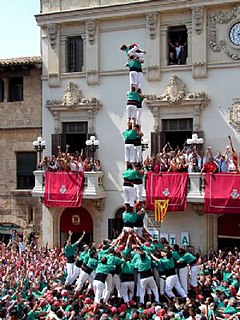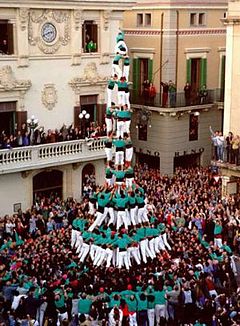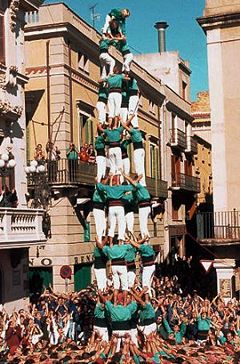Castellers de Vilafranca
The Castellers de Vilafranca are a cultural and sporting institution in Catalonia whose goal is the construction of castells . It is a registered association founded in 1948, which dates back to the Ball de Valencians (18th century), the preliminary stage of today's castells.
The association currently has more than four hundred castellers, members who take part in the construction of the castells, of all ages, in free and voluntary form and without any social, political, cultural or religious distinctions. They all share the same preference for building castells, democratic values, cooperation and teamwork, the constant spirit of overcoming, and the ambition to continue to be a top leader in building castells. The seat of the Castellers de Vilafranca is in Cal Figarot, Casa Via Raventós, a building acquired in 1983.
The Castellers de Vilafranca are one of the most important and influential associations in Vilafranca del Penedès, and have often represented the Catalan country and its culture abroad. More than five hundred members support the association, as well as various public and private institutions. In addition to the castell demonstrations during the season - mainly from April to November - the association also organizes other cultural, sporting, educational, social and gastronomic activities.
This contribution over 60 years to the Catalan popular culture of associations has been recognized by the municipality of Vilafranca del Penedès with the award of the Medalla de la Vila (city medal), at national level by the Generalität de Catalunya (regional government) the Creu de Sant Jordi (Saint George's Cross ).
history
The colla (association) Castellers de Vilafranca was founded in September 1948 by Oriol Rossell, he was the first cap de colla (leader of the group). The beginnings also meant the construction of the first seven-story castells and with the close relationships with other current colles. During these years, cap de colla were Oriol Rossell (1948–1952) and Ramon Sala (1953–1955) and the color of the shirts was first pink and later red.
In 1956 the colla was practically inactive due to internal upsets. In 1957 a reorganization was carried out and the green color for the shirts was determined. Seven-story castells were built between 1957 and 1968 and the main success was the cinc de set (seven floors with five castellers per floor). From 1969 to 1974, the colla made a great leap in quality and the torre de set (seven-story tower with two castellers per floor) and the first eight-story castells were built: the quatre de vuit (eight floors with four castellers per floor), the tres de vuit (eight floors with three castellers per floor), the pilar de sis (six-story column with one casteller per floor) and the torre de vuit amb folre (eight-story tower with two castellers per floor, and a support ring around the second floor). In 1972 the Castell competition was won in Tarragona. These years were cap de Colla Josep Pedrol (1957–1959), Carles Domènech (1960–1961), Joan Bolet (1962–1963), Gabi Martínez (1964–1969), Lluís Giménez (1970–1973) and again Gabi Martínez, (1974).
In 1975 colla undertook a complete structural transformation internally: the previous, almost exclusive management of the Cap de Colla was replaced by a technical chamber membership team. 1981 is another year in which internal changes are made: it was decided that the Castellers will not be paid individually. This has split the group. Between 1975 and 1982 the Colla was able to keep the eight-story castells, but with a lot of difficulties. 1983 and 1984 were years of resurgence and consolidation of the eight-story castells, but the definitive change took place in 1985 with the first dismantling of the cinc de vuit (eight floors with five castellers per floor). This opened the way to the nine-story Castells Folrats (second floor supported by a group). In 1987 the colla set up the first tres i quatre de nou amb folre (nine-storey castells with three or four castellers per floor and support ring around the second floor), in 1987 the colla dismantled the first three and in 1990 the four. From 1975 to 1994 the Cap de Colla Carles was Domènech.
Between 1995 and 2004 the Colla fell into a spiral of success. During these years they achieved the highest goals: construction and dismantling of the torre de nou amb folre i manilles (nine-story tower with 2 castellers per floor, with a support ring around the second floor and a slightly smaller support ring around the third floor), the pilar de set amb folre ( Seven-story column with one casteller per floor and a support ring around the second floor), the pilar de vuit amb folre i manilles (eight-story column with one casteller per floor, with a support ring around the second floor and a slightly smaller support ring around the third floor), which is the first of the 20th century. Then there is the quatre de vuit amb l'agulla (eight floors with four castellers per floor, and inside a column with one casteller per floor, also for the first time in the 20th century), the quatre de nou amb folre i l'agulla (nine floors with four castellers per floor and support ring around the second floor, and inside a column with one casteller per floor). This castell was built for the first time in the history of the castellers. In addition there is the cinc de nou amb folre (nine floors with five castellers per floor and support ring around the second floor) and the tres i quatre de nou amb folre simultanis (at the same time two nine-storey castells with three or four castellers per floor and support ring around the second floor , also for the first time) and the structure de Torre de vuit (eight-storey tower with two castellers per floor, the first of the 20th century), the quatre de nou (nine floors with four castellers per floor) and, for the first time, the tres de deu amb folre i manilles (ten floors with three castellers per floor, with a support ring around the second floor and a slightly smaller support ring around the third floor).
In addition, the Colla was the winner of the Castells competition in Tarragona in 1996, 1998, 2002 and 2004. In 2005, the Colla achieved the construction of the torre de 9 amb folre (nine-story tower with two castellers per floor and support ring around the second floor), which is considered to be the most difficult castell to date.
Francesc Moreno "Melilla" was Cap de Colla (head of the group) from 1995 to 2003 and Lluís Esclassans from 2004 to 2007. David Miret was elected in December 2007 as the new Cap de Colla.
Obtained castells
Throughout history, the Castellers de Vilafranca have obtained the vast majority of the castells shown. Below is a list of the castells that the Colla has acquired with the first assembly, assembly and dismantling date.
| Castell | Assembled and dismantled | Built up, collapsed |
|---|---|---|
| Torre de nou amb folre | 30 Aug 2005 ** | |
| Tres de deu amb folre i manilles | Nov. 15, 1998 ** | |
| Quatre de nou amb folre i tres de nou amb folre simultanis | 31 Aug 2001 ** | |
| Torre de vuit | Nov 1, 1999 * | |
| Quatre de nou | Nov 1, 2002 | |
| Quatre de nou amb folre i agulla | Nov. 1, 1996 ** | Nov. 1, 1995 ** |
| Cinc de nou amb folre | Nov 1, 1997 | Aug 30, 1997 |
| Pilar de vuit amb folre i manilles | 28 Sep 1997 * | 31 Aug 1995 * |
| Torre de nou amb folre i manilles | Aug 30, 1995 | |
| Torre de nou amb folre i manilles | Aug 30, 1995 | |
| Tres de nou amb folre | Aug 30, 1989 | Aug 31, 1987 |
| Quatre de nou amb folre | Nov 1, 1990 | Nov 1, 1987 |
| Quatre de vuit amb l'agulla | Oct 8, 1995 * | |
| Cinc de vuit | Aug 30, 1985 | |
| Torre de vuit amb folre i pilar de set amb folre simultanis | 31 Aug 2006 ** | |
| Pilar de set amb folre | Oct. 1, 1995 | May 14, 1995 |
| Tres de vuit amb agulla | 29th 2006 ** | |
| Dos pilars de sis simultanis (un de carregat) | 31 Aug 2001 ** | |
| Torre de vuit amb folre | Nov. 17, 1974 | Oct 12, 1973 |
| Tres de vuit | Aug 30, 1974 | Oct. 1, 1972 |
| Pilar de sis | Aug 30, 1972 | Dec. 19, 1971 |
| Quatre de vuit | Aug 30, 1971 | Oct 12, 1969 |
| Nou de set | Dec 11, 1988 | |
| Torre de set | Aug 24, 1969 | |
| Tres de set aixecat per sota | Nov 25, 1973 | |
| Sis de set | Jan. 21, 1997 | |
| Cinc de set amb agulla | April 19, 2008 ** | |
| Cinc de set | 26 Sep 1965 | Aug 30, 1965 |
| Tres de set amb l'agulla | 10 Aug 1996 ** | |
| Quatre de set amb l'agulla | Aug 5, 1954 | Aug 31, 1953 |
| Tres de set | Aug 31, 1949 | |
| Quatre de set | Aug 31, 1949 | |
| Torre de sis | June 16, 1949 | |
| Pilar de cinc | Sep 14 1948 |
- *: First of the 20th century
- **: First in Castells history
organization
As part of the general organization of the Colla, the management has been divided into two large areas: technical area (technical team or simply the technology) and administrative area (board of directors).
The technical team covers all matters related to the construction of the castells. The Cap de Colla (head of the group) is responsible for this area. The management team consists of the Sotscap de Colla (deputy head of the group) and two technical advisors. Three areas of responsibility depend on this core: the children's team, the team responsible for the substructure and the first and second support ring, and the medical and sports team. Each of these areas is responsible for logistics, technical information and physical training.
The board deals with the administration. Its first responsibility is the administration of the funds and the public representation of the Colla. The leadership corresponds to the president. The secretary and five vice-presidents depend on him and lead five thematic areas: social, economic, institutional, equipment and marketing as well as media areas. The Colla also has three advisory councils: International Relations, Legal Advice and Wise Men’s Council.
Current organizational chart
Technical management
- Cap de colla (group leader): David Miret i Rovira
- Sotscap de colla (deputy head of the group): Toni Bach i Lleal
- Technical advisers: Jordi Colomera i Salla, Joan Badell i Roses
Board
- President: Miquel Ferret i Miralles
- Secretary: Joan Vendrell i Olivella
- Vice-President Social Affairs: Àlex Sánchez-Granados
- Vice-President Economic Area: Miquel Ropero i Ventosa
- Vice-President Institutional Area: Xavier Escribà i Vivó
- Vice-President Equipment area: Joan Mestres i Arnan
- Vice-President Marketing and Media: Francesc Bou i Pijoan
Advisory Councils
- International Relations
- Legal advice
- Wiserrat
Cal Figarot, registered office
The headquarters of the Castellers de Vilafranca is Cal Figarot, Casa Via Raventós, It was acquired in 1983. It is a neo-Gothic building constructed in 1888 and designed by the architect August Font y Carreres. In Vilafranca, medieval elements were inserted into a private building for the first time. In this building, the balconies, the entrance hall, the main staircase, some halls and above all the inner garden - the neuralgic core of the social seat - stand out. In 1998 the Colla acquired an adjoining 600 m² restaurant and a cellar. After the corresponding renovations, the inner courtyard was expanded. The Colla also has other rooms such as a gym, secretariat, various multifunctional rooms and a coffee restaurant.
The Castellers de Vilafranca in the world - International presence
The Castellers de Vilafranca are one of the colles with a more international focus. They performed at the following events:
- 1973 at the festival in Parí organized by the newspaper L'Humanité.
- 1978 at the two Catalan weeks in Geneva.
- 1978 in Italy with performances in Alguer and Sassari (Sardinia).
- 1982 in Portugal with Castells buildings in Lisboa, Sintra, Estoril, Coimbra and Porto.
- 1984 in Italy with screenings in Pisa, Siena, Rome, Vatican and Florence.
- 1987 in Béziers, France.
- 1988 in Italy as part of the events of the Catalonia Millennium, and performances in Pisa, the Vatican and Rome.
- 1990 in the Basque Country with appearances in Bergara, Antzuola, Zumarraga and Urretxo.
- 1990 in Italy, this time in the north: Feltre (al palio), Niccia and Melere (localities of the municipality of Trichiana) and Venice.
- 1991 again in France with performances in Toulouse during the International Assembly of Sardana (Catalan folk dance) in Carcassonne.
- 1991 in Luxembourg and Germany with demonstrations in Luxembourg (capital), Moers, Wolfenbüttel, Hanover, Berlin and Frankfurt.
- 1992 at the world exhibition in Seville as part of the Catalonia Day.
- 1993 in Santiago de Compostela during the Xacobeo'93 events.
- In the same year, five-country tour: France (Marseille), Italy (Lecco, Melzo, Bergamo), Slovenia (Ljubljana, Postojna, Otočec, Novo mesto, Črnomelj), Austria (Klagenfurt) and Monaco (Montecarlo).
- again in France in the same year, with performances in París and in Poix de Picardie.
- 1994 in Italy for the fifth time in Venice and Mestre during the Venetian Carnival.
- in France (Villeurbanne, Lyon) in the same year.
- 1994 in the Netherlands and Belgium with performances in Amsterdam, Enschede, Aalten, Almelo, Emmen and Brussels.
- 1995 again in the Basque Country with an appearance in Tudela.
- 1996 in Denmark, in Copenhagen and Holte.
- In the same year, in France (Metz), the Netherlands (Maastricht) and in Belgium (Bree).
- 1999 in Sobradiel, Aragón.
- 2001 in Bühl (Germany), “sister city” of Vilafranca del Penedès.
- 2002 in Salamanca.
- 2004 back in France with appearances in Dunkerque.
- 2005 in the Basque Country, with appearances in Donostia and Elorrio.
- 2006 in France, with an appearance in Steenvoorde.
- Again in Aragón in 2006, during the festivities of Binéfar.
- 2007 Appearance in Germany at the Frankfurt Book Fair.
- in January 2008 appearances in Chile, the first appearance of a Catalan Castellers Colla in the southern hemisphere.
- The Castellers de Vilafranca also participated in the opening ceremony of the XXV. Took part in the 1992 Summer Olympics in Barcelona, undoubtedly the most watched Castellers performance in the world.
- The Colla also took part in the world presentation of Noah Gordon's novel “El Celler” (The Winery), which took place in Vilafranca del Penedès (2007).
The Castellers de Vilafranca also contributed to the diffusion of the Castellers fact in the area of the Països Catalans (Catalan Countries):
- Performances in northern Catalonia and Occitania (southern France): six times in Perpignan (1970, 1977, 1982 [based on the Union Sportive Arlequins de Perpignan USAP], 1989 [Fête des Mules], and 1997 and 1998), in Toluges (1970 ), as part of the peace and standstill celebrations, and in Cotlliure (1984), in Banyuls de la Marenda (1986), three times in Vilafranca de Conflent (1985, 1988 and 1989), once in the monastery of Sant Miquel de Cuixà (1985), once in Prada de Conflent [in the Catalan Summer University] (1988) and once in Baó, as part of the First Assembly of Catalan in Northern Catalonia (2002).
- Four performances in the Principat d'Andorra: in Encamp (1971), Andorra la Vella and Sant Julià de Lòria (1976) [one of the events of the Congress of Catalan Culture], in Les Escaldes, again in the capital of Les Valls (1983) and again in Les Escaldes (1985).
- Two tours in the Land of Valencia: the first in the Ribera del Xúquer region (1979), with performances in Carcaixent, the monastery d'Aigües Vives, Sueca, Cullera and Algemesí, as well as the construction of a pilar de cinc (five-story column) in front of the House of the singer and composer Raimon , in Xàtiva; the second (1981) with performances in Alcoi, Benidorm and Alacant. Later demonstrations in Carcaixent (1985), in Algemesí (1993 and 2000), Castelló (2000) [13. Language Festival], Olleria and Benicarló (during the Valencian Community National Festival).
- Demonstration in Palma de Mallorca (1980) and in Manacor (2001).
- The one mentioned above in l'Alguer (1978).
Participation in the Castells competition in Tarragona
The Castellers de Vilafranca have won the Concurs de castells de Tarragona seven times:
- VII Castells Competition in Tarragona, 1972
- VII Castells Competition in Tarragona, 1996
- XVII Castells Competition in Tarragona, 1998
- XIX Castells Competition in Tarragona, 2002
- XX Castells Competition in Tarragona, 2004
- XXI Castells Competition in Tarragona, 2006
- XXII Castells Competition in Tarragona, 2008






















